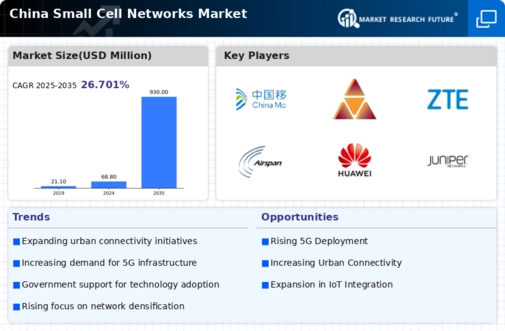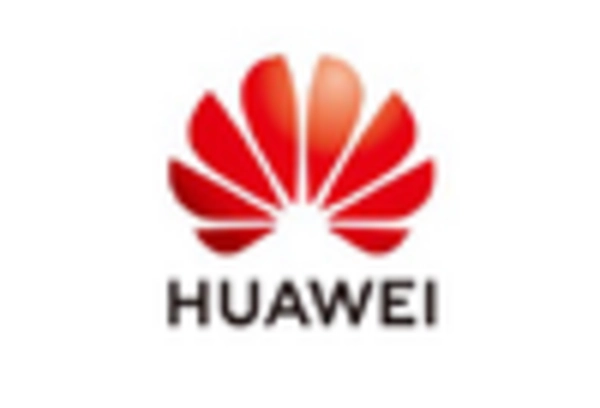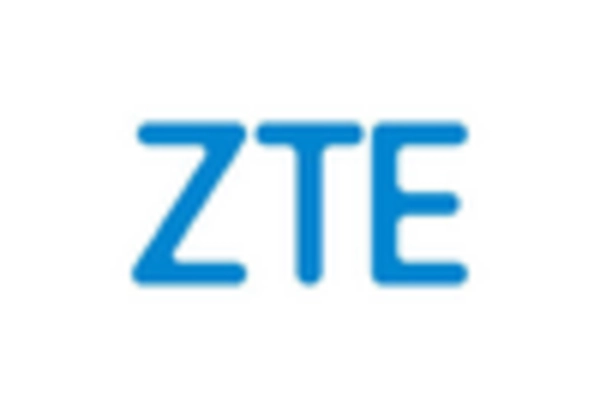Increased Mobile Data Consumption
The surge in mobile data consumption in China is significantly influencing the small cell-networks market. With the proliferation of smartphones and mobile applications, data traffic has escalated dramatically. Reports suggest that mobile data traffic in China is expected to grow at a CAGR of approximately 30% over the next few years. This increase in demand for high-speed data services necessitates the deployment of small cell networks, which can efficiently handle localized traffic and alleviate congestion on macro networks. As consumers increasingly rely on mobile services for various applications, including streaming and online gaming, The small cell-networks market is likely to experience substantial growth to meet this rising demand.
Urbanization and Population Density
The rapid urbanization in China is a critical driver for the small cell-networks market. As cities expand and populations concentrate in urban areas, the demand for enhanced mobile connectivity intensifies. In densely populated regions, traditional macro cell towers often struggle to provide adequate coverage and capacity. Small cell networks, with their ability to be deployed in various locations, offer a solution to this challenge. According to recent data, urban areas in China are projected to account for over 70% of the population by 2030, necessitating a robust infrastructure to support mobile data traffic. This trend indicates a growing reliance on small cell networks to meet the connectivity needs of urban dwellers, thereby propelling the market forward.
Government Initiatives and Investments
Government initiatives and investments in telecommunications infrastructure are crucial drivers for the small cell-networks market. The Chinese government has been actively promoting the development of 5G technology and enhancing mobile network capabilities. Initiatives aimed at improving digital infrastructure, such as the 'Broadband China' strategy, are expected to lead to increased funding for small cell deployments. Furthermore, the government's focus on smart city projects creates a favorable environment for the adoption of small cell networks, as these technologies are essential for supporting the connectivity needs of smart applications. As a result, The small cell-networks market is likely to benefit from ongoing government support and investment in telecommunications infrastructure.
Competitive Landscape and Market Dynamics
The competitive landscape within the telecommunications sector in China is a significant driver for the small cell-networks market. With multiple operators vying for market share, there is a strong incentive to enhance service offerings and improve network performance. This competition encourages investments in small cell technology, as operators seek to differentiate themselves by providing superior connectivity solutions. Additionally, partnerships between telecom operators and technology providers are becoming increasingly common, facilitating the development and deployment of innovative small cell solutions. As the market dynamics evolve, the small cell-networks market is expected to grow, driven by the need for operators to stay competitive in a rapidly changing environment.
Technological Advancements in Network Infrastructure
Technological advancements play a pivotal role in shaping the small cell-networks market. Innovations in network infrastructure, such as the development of advanced antennas and backhaul solutions, enhance the efficiency and performance of small cell deployments. In China, the integration of cutting-edge technologies, including artificial intelligence and machine learning, is expected to optimize network management and improve user experiences. These advancements not only facilitate the deployment of small cells in challenging environments but also enable operators to manage their networks more effectively. As technology continues to evolve, the small cell-networks market is poised for growth, driven by the need for more efficient and reliable connectivity solutions.

















Leave a Comment